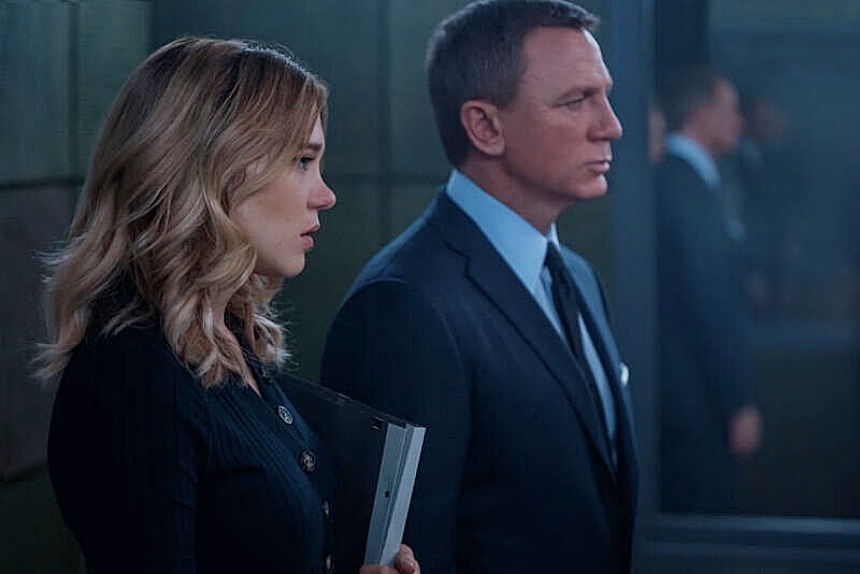No Time to Die
⭐⭐⭐⭐
Rating: PG-13
Run Time: 2 hours 43 minutes
Stars: Daniel Craig, Léa Seydoux, Rami Malek, Christoph Waltz
Writers: Neal Purvis, Robert Wade, Cary Joji Fukunaga
Director: Cary Joji Fukunaga
What is the greatest James Bond film of all time? If you ask the readers of 007 Magazine (and who would know better?), the answer is not Sean Connery’s genre-defining Goldfinger (my personal fave) nor Daniel Craig’s genre-recalibrating Skyfall — but instead the least-seen Bond movie of them all, the one and only entry starring former model George Lazenby, 1969’s On Her Majesty’s Secret Service.
Cary Joji Fukunaga, the co-writer/director of No Time to Die, clearly got that memo. Craig’s swansong as Bond spends much of its two hours and 43 minutes not only quoting liberally from that 52-year-old footnote — but also dwelling heavily on the themes tentatively touched on way back then, most notably: Does James Bond really want to be the man he has become?
One cannot imagine Sean Connery, nor Roger Moore, nor Pierce Brosnan suffering from such an identity crisis. But Craig, an actor of cunning resourcefulness, has been excavating under 007’s skin from the moment he took on the role in 2006. And here, as Craig hangs up his holster for the last time, Bond finally finds the words to express the man’s profound loneliness — while not for one second begrudging him the adrenaline-infused thrill of saving the world one last time.
Here, we find Bond in retirement, living the simple life — which for Bond means tooling along the Mediterranean coast in a sleek Aston Martin convertible, spending each night in a different plush villa with the love of his life, Madeleine (Léa Seydoux), the beautiful psychiatrist with whom he rode off into the sunset at the end of 2015’s Spectre.
But we’re not paying good money (and venturing into an actual movie theater) to see James Bond sit around getting fat on fusilli. When he pays an impromptu visit to the grave of his long-lost love Vesper (killed in Craig’s initial Bond outing, Casino Royale, way back in 2006), he is nearly blown up by a booby trap, then ambushed by 20-odd trained killers in cars and on motorbikes.
Bond immediately assumes Madeleine has betrayed him. Of course, she has not, but then again, were all these guys just sitting around for years on the villain’s payroll, motors running, waiting for Bond to show up? It’s a classic Bond movie imponderable, the sort of conundrum the ensuing action sequence erases from your mind until, on the drive home, you suddenly say to yourself, “Hey…wait a minute…”
In the best Bond tradition, No Time to Die offers up such implausibilities with shameless abandon, like a helpful bartender serving one martini after another, fully aware that each serving is dulling your critical thinking skills by the minute.
Unable to trust Madeleine, Bond puts her on a train and retreats to a tropical island. Flash forward five years, and all of a sudden both MI-6 and the CIA are desperately trying to lure Bond out of retirement for one last, dreadfully important mission.
From here the plot unfolds with surprising efficiency, considering the film’s run time. This time we get two Bond villains for the price of one: Christoph Waltz is back as Blofeld — one of Bond’s most enduring nemeses — and Bohemian Rhapsody Oscar winner Rami Malek turns up as Safin, a scar-faced madman who is intent on wiping out most of Earth’s population via nanobots that genetically target individuals. In the tradition of Bond baddies, Safin’s evil motives are an afterthought, and no one even attempts to explain how Safin, an orphan, amassed the fortune required to bankroll a billion-dollar project employing and supporting thousands on a remote island.
We need only know he’s rotten to the core and, as one character colorfully puts it, “crazy as a bag of bees.”
Bond soon discerns that the key to unraveling the plot is in getting Blofeld, now kept in a super-high security prison, to talk. And he’ll only confide in his jailhouse shrink who happens to be, yep, Madeleine — who also has a wildly coincidental tragic history with Safin.
Once more thrust into close proximity with the woman he’s never stopped loving, Bond comes to realize the world is moving on without him — there’s even a new 007, and it’s a woman (Lashana Lynch). A life empty of human connection, he begins to realize, is one without meaning (although one could argue that a life spent stopping Dr. No from sabotaging America’s space program, preventing Goldfinger from irradiating the U.S. gold supply, plus foiling a half-dozen or so plots to trigger worldwide nuclear war — not to mention facing down voodoo priests and an evil publisher based on Rupert Murdoch — must count for something).
Of course, Bond’s catharsis does not come without a heapin’ helping of “martinis, girls and guns,” as Sheryl Crow sang in the Bond epic Tomorrow Never Dies. Miraculously, the slam-bang script, brisk direction, and ultra-committed cast — including Bond’s regular ensemble headed by Ralph Fiennes, Naomie Harris, Ben Whishaw and Jeffrey Wright — breezily overcome the inevitable nonsense of No Time to Die, slicing through the incongruities like Oddjob’s bowler through butter. The set pieces are masterfully staged — even as Bond is chased through a labyrinth of Medieval streets, or across a forested Norwegian battleground, or up and down the hallways of an abandoned World War II sub base, director Fukunaga (Beasts of No Nation, True Detective) and editors Tom Cross (Whiplash) and Elliot Graham (Milk) don’t allow one second when we are unaware of our exact position and what the stakes are. Hans Zimmer’s expansive score effectively samples not only themes from previous Bond films, but grand opera as well.
Much has been made of No Time to Die’s run time — you could drop your family off for the film at a Philadelphia multiplex and drive round-trip to Newark in time to pick them up — but you’d be hard-pressed to single out any extra baggage. Perhaps that’s a trait of the best Bond films: I’m reminded of sitting through a double feature of Dr. No and Goldfinger in the 1960s and wondering afterward where the time went.
Finally, there’s the film’s almost mystical connection to On Her Majesty’s Secret Service. Besides repenting of their casting anomaly — when the film’s box office returns were a bit lower than expected, Sean Connery was summoned back to “rescue” the franchise — the producers also ran screaming from any hint of Bond being a sentimental soul. Prior audiences were used to Bond films ending with an explosion, or a witticism, or a romantic clinch. But here was Bond, minutes after his wedding, holding the lifeless body of his murdered bride in his arms, sobbing (honestly, I don’t know how a fledgling actor like Lazenby pulled that off so effectively).
Perhaps because the film is staged as a farewell to Daniel Craig, the filmmakers have been emboldened not only to recapture the spirit of that strong-but-sensitive Bond, but also to rehabilitate On Her Majesty’s Secret Service as a landmark moment in the franchise — right down to playing Louis Armstrong’s “All The Time in the World,” Bond’s love theme from the 1969 film, over the closing credits.
“James Bond Will Return,” the final crawl assures us, just as it has at the end of every 007 film since 1962. But for a galaxy of reasons, there’s every expectation that Bond will never be quite the same.
Featured image: Nicola Dove © 2021 DANJAQ, LLC AND MGM. ALL RIGHTS RESERVED
Become a Saturday Evening Post member and enjoy unlimited access. Subscribe now




Comments
Great review, Daniel Craig did an amazing job with this character . The final scene I was overcome with emotion as I hoped he would survive this, but alas it was not to be . Farwell Mr Bond , but not goodbye
Interesting title and well written review. The thing is, “No Time To Die” is exactly ABOUT why it IS time for this nearly 60 year old film series/franchise TO die Bill. We both know it, but it won’t.